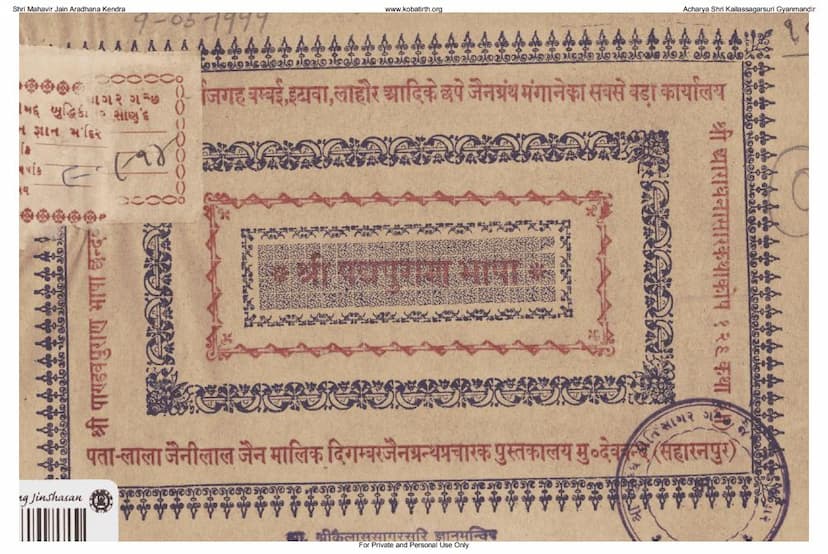Padmapuran Bhasha
Added to library: September 2, 2025

Summary
The provided text is a comprehensive Hindi summary of the Padma Purana, a significant text within the Digambar Jain tradition. Here's a breakdown of its key aspects and themes based on the extensive text:
Book Title & Publisher:
- Title: Padmapuran Bhasha (पद्म पुराण भाषा - The Padma Purana in vernacular language)
- Author/Publisher: Digambar Jain Granth Pracharak Pustakalay (दिगम्बर जैन ग्रन्थ प्रचारक पुस्तकालय - Publisher of Digambar Jain Texts)
Content and Scope:
The Padma Purana (as presented in this summary) is a vast narrative detailing the lives and legends of various important figures and events within Jainism, particularly focusing on the lineage of Tirthankaras and the epic tale of Rama as interpreted through a Jain lens. The summary is structured with a detailed table of contents spanning numerous "Mahā Adhikārs" (Great Chapters) and individual topics, indicating a rich and extensive narrative.
Key Figures and Themes:
-
Tirthankaras: The text prominently features the lives of Tirthankaras, starting with Lord Rishabhanatha (the first Tirthankara) and progressing through others. The summary includes details about their birth, life, penance, and liberation (nirvāṇa). The descriptions of their celestial births, the sixteen dreams of Rishabhanatha's mother, and their divine ascents are highlighted.
-
Lord Mahavira: The text begins with a Mangalacharan (auspicious invocation) mentioning Lord Mahavira, the 24th Tirthankara, and sets the stage for the Jain teachings. The presence of Lord Mahavira's samosharana (divine assembly) and his sermons are described.
-
Rama's Life and the Ramayana: A significant portion of the text is dedicated to the story of Rama, presented from a Jain perspective. This includes:
- King Dasharatha: His lineage, his queens (Kausalya, Sumitra, Kaikeyi), and the birth of Rama, Lakshmana, Bharata, and Shatrughna.
- Rama's Exile: The circumstances leading to it, including the role of Kaikeyi.
- Sita: Her birth, her marriage to Rama, and her subsequent trials.
- Hanuman: The narrative explains Hanuman's birth and his connection to Ravana and other characters.
- Ravana and His Dynasty: The text details the lineage of Ravana, his rise to power, his kingdom of Lanka, his interactions with gods (Indra), and his eventual defeat. The complex relationships and conflicts involving figures like Kumbhakarna, Vibhishana, Meghavahana, Bali, Sugriva, and Ravana's clan are described.
- Warfare and Diplomacy: The narrative involves extensive descriptions of battles, alliances, and the strategies employed by various characters.
- Moral and Spiritual Lessons: The story of Rama is used to impart Jain ethical principles, emphasizing karma, dharma, non-violence (ahimsa), and the path to liberation.
-
Cosmology and Jain Philosophy:
- Lokakash and Alokakash: Descriptions of the Jain universe, including the three worlds, continents, oceans, mountains (like Sumeru), and the celestial realms.
- Kalachakra: The concept of time cycles (Avsarpini and Utsarpini) and their influence on lifespan, physique, and societal conditions is explained.
- Tattvas (Principles): The text touches upon fundamental Jain principles like Jiva (soul) and Ajiva (non-soul) and their classifications.
- Karma: The impact of karma on the cycle of birth, death, and rebirth across different realms (hell, animal, human, divine) is a recurring theme.
- Dharma: The text strongly emphasizes the importance of Jain dharma, outlining the distinctions between the paths of monks (yati) and lay followers (shravaka), their respective vows, and the significance of virtues like non-violence, truthfulness, charity, and austerity.
- Morality and Ethics: The narrative serves as a vehicle to teach about the consequences of virtuous and sinful actions, the importance of righteousness, and the pursuit of liberation.
-
Genealogies and Lineages: The text meticulously traces the genealogies of various important clans, including:
- Ikshvaku Dynasty (Suryavansha): Tracing from Lord Rishabhanatha through King Ikshvaku and the solar lineage.
- Chandra (Lunar) Dynasty: The lineage associated with the moon.
- Vidyadhar Clans: The origins and characteristics of these celestial beings are described, including their kingdoms and interactions with humans.
- Harivansha: The lineage associated with Krishna and Balarama, as interpreted in Jainism.
- Ravana's Clan: Descendants of Sumali, leading to Ravana and his kin.
- Vanara Clan: The lineage of characters like Bali and Sugriva.
-
Mangalacharan (Invocation): The text begins with invocations to the Pancha Parameṣṭhī (the five supreme beings: Arihant, Siddha, Āchārya, Upādhyāya, Muni) and other revered figures in Jainism, highlighting the devotional aspect of the scripture.
-
Dispute Resolution and Justice: The text occasionally touches upon how justice is administered, disputes are resolved, and the consequences of actions are seen.
Narrative Style and Interpretation:
- Storytelling: The Padma Purana is presented as an epic narrative, weaving together spiritual teachings with mythological events.
- Jain Interpretation: It's crucial to note that this is a Jain retelling of the Ramayana and other Puranic stories. The characters and events are interpreted to align with Jain philosophical principles. For instance, characters like Ravana are sometimes portrayed with more complexity than in other traditions, and their actions are viewed through the lens of karma and rebirth.
- Moral Instruction: Each story or event is often imbued with a moral or spiritual lesson, guiding the reader towards righteous conduct and spiritual progress.
Overall Significance:
The Padma Purana in this context is more than just a historical or mythological account; it's a didactic text designed to educate and inspire Jains. It reinforces core Jain beliefs about karma, reincarnation, the Tirthankara path, and the importance of ethical living for spiritual liberation. The extensive detail in the table of contents suggests a detailed exploration of each character's life, the cyclical nature of existence, and the ultimate goal of Moksha (liberation).